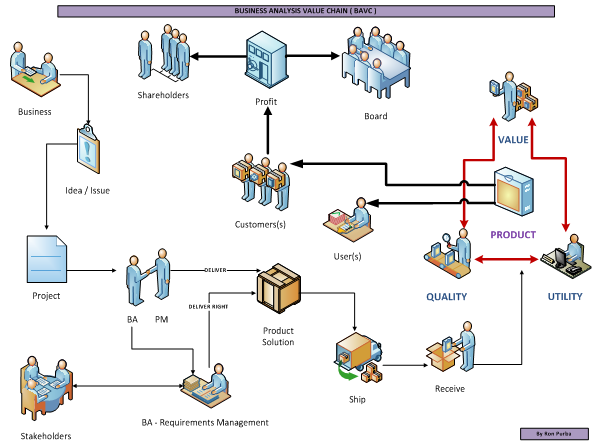
Business Analysis Triple Constraint & Value Chain
Most of us are familiar with the Triple-Constraint model from the world of Project Management where three variables, Time, Cost & Quality (Scope) are continually competing with each other under the watch and control of the Project Manager.
Basically, if any one of these dimensions is changed it has a consequential effect to the other two remaining dimensions or vice versa.
Ok so what? Let’s hold that thought …….Is there such an equivalent model within the field of Business Analysis?
I’d like to share some thoughts and while I can’t propose a like-for-like model using the same logic as the PM model, I think I’ve come up with a rudimentary Business Analysis Triple Constraint (BATC) using three key metrics or points of scale which govern how a product &/or service is brought to market & assessed for success.
These are essentially Quality, Utility & Value, all three constituent pillars required to form a successful Product for the consumer.
Before we examine this in more depth let’s revisit what we understand by these terms.
- PRODUCT – The definition in this context is extensible & interchangeable to include:
- A new service (B2B or B2C)
- A new solution / software (B2B or B2C)
- A new or optimised process
Business Analysis activities are primarily geared around delivery of a PRODUCT that is:
-
- Fit-for-purpose
- Adds or creates business value
- Addresses a specific business need(s) and/or resolves a business problem(s)
- Delivers the right capabilities with benefits and meets customer expectations.
- QUALITY – The scale / ability of something to perform satisfactorily in service, suitable for its intended purpose & function. A degree of excellence and high-grade.
- UTILITY (UTILISATION) – The scale of being useful, utilised, profitable or beneficial. Utility is a measure of the happiness or satisfaction gained from a good or service.
- VALUE – The regard that something is held to deserve; the importance, worth, or usefulness of something
- CONSUMER – A type of customer, user, purchaser of a Product
So some observations come to mind:
- In the optimal scenario, if a product has high quality then there is likely to be higher usage or adoption i.e. high utility and an overall higher value to the consumer.
- In the sub-optimal scenario, if the product has low quality then there is likely to be lower utility and hence lower derived value.
Therefore to calculate the Product Rating the formula broadly must possess the following attributes / values. The higher the value of Value (no pun intended) the more successfully rated the product becomes. - Product Rating = (Scale of Quality + Scale of Utility = Scale of Value ) or P = (Q + U = V)
What about some other scenarios:
- Can there be a product which has high quality and high utility but low value?
- Can there be a product which has low quality & low utility but high value?
- Given the real world I can’t envisage any legitimate examples where these scenarios exist (I could be wrong!)
- Can there be a product which has high quality & low utility and hence reduced or average value?
- Can there be a product which has low quality & high utility and hence reduced or average value?
- Perhaps these scenarios are possible.
I could attempt to list more permutations, but the point I’m making here is that it is not as easy to replicate the same logic used by the PM Triple Constraint and apply this to the BA version.
The BA version is more like a sliding-scale where it is possible to go forward and backward incrementally across the three parameters in terms of low to high Quality, low to high Utility, & low to high Value. The aggregated scores are used to derive an overall Product rating.
Whereas the target focus for Project Managers has been geared around Time, Budget and Scope for a successful delivery, the Business Analysis discipline calibrates its efforts around Quality, Utility and Value to deliver the right product.
Business Analysts exist to ensure the product / solution is what was ordered (once the lid on the box is opened – see diagram). That there is the right solution for the right problem. This is opposite to the right solution to the wrong problem or wrong solution to the right problem. That business value is created by resolving business needs and delivering perceived benefits and new capabilities. By ensuring that the product / solution works & does what it’s supposed to do effectively (utility)
Some organisations are more aggressively focused on jumping and fast-tracking to design and delivery mode because of the bias to the traditional Project Management Triple Constraint.
They run the risk that without equal diligence to the Requirements Definition and Management process this will lead to short cuts & costly re-work (something we could discuss & debate for hours but a subject for another time & article.)
In the new business paradigm if these two models co-exist in equilibrium, and are used intelligently in alliance, the result is a more efficient Project Delivery environment achieving higher success rates. If used as mechanisms to compete / conflict with each other, this creates an unhealthy tension and often leads to lower Project and Product success rates.
To counter this mindset we as a profession need to be more assertive and demonstrate the wider value of Business Analysis, so perhaps it’s time we wield our own version of the Triple Constraint to show the business world.
With this final thought, I advocate it would serve the Business Analysis profession better by referring to this notion as the Business Analysis Value Chain (BAVC) rather than the term Business Analysis Triple Constraint.
Maybe I’m on the wrong track here but it kept me thinking for a while…What about you?
Business Analysis Value Chain

Don’t forget to leave your comments below.